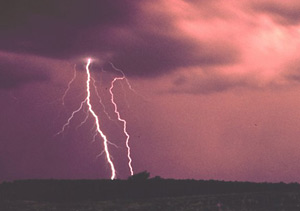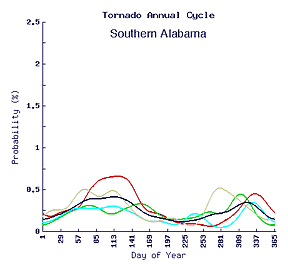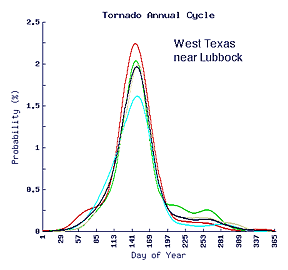NSSL researcher answers the question: "When and where
does severe weather occur?"
...continued
Example: The Annual Tornado Cycle

The annual tornado cycle for southern Alabama is contrasted with the cycle for west Texas below. Each graph shows the probability of a tornado, of any strength, occuring on each day of the year within 25 miles of the point I had clicked on. The black line is an average of 20 years of data. Each colored line shows the chances based on a statistical analysis of a 5 year period (see the full size graphic to see the color key).
These graphics show how very different tornado occurrence is in various parts of the U.S.
Southern Alabama never sees a zero chance, but never has a very high chance, either, with the maximum being up to 0.5% through the spring and fall months. This implies that you - or an emergency manager, or an insurance company - would want to be aware that you have a (small) chance of seeing a tornado any time throughout the year.
In west Texas, on the other hand, there is nearly a zero chance in December and January (never say never!), and a very clear maximum of tornado occurrence in about the third week of May, with a 2% chance on any given day around that time. This 2 to 2.5% peak in late May, which can be seen in western, western-north, and the panhandle of Texas and western Oklahoma, is the highest chance of a tornado anywhere in the U.S. on a given day.
 |
 |
(Left) The tornado annual cycle for southern Alabama shows a consistent, but minimal, threat year-round. (larger image) (Right) The tornado annual cycle for west Texas shows a clear spring cycle, with chances very low and tapering off through the fall. (larger image) |
|
See the annual cycle for your area by doing the following:
Data are only available for the continental US. |
|